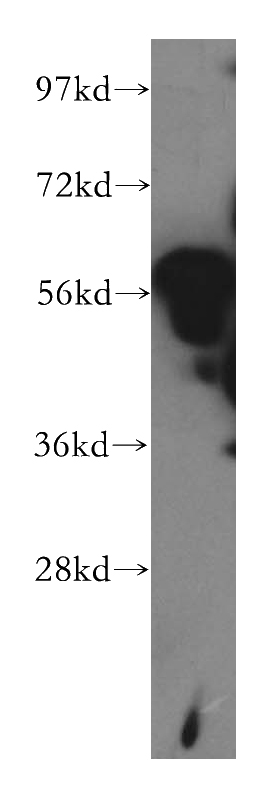-
Product Name
XRCC4 antibody
- Documents
-
Description
XRCC4 Rabbit Polyclonal antibody. Positive WB detected in K-562 cells, COLO 320 cells, HepG2 cells. Positive IP detected in HepG2 cells. Positive IHC detected in human breast cancer tissue, rat small intestine tissue, rat testis tissue. Observed molecular weight by Western-blot: 55kd
-
Tested applications
ELISA, WB, IHC, IP
-
Species reactivity
Human, Rat; other species not tested.
-
Alternative names
DNA repair protein XRCC4 antibody; XRCC4 antibody
-
Isotype
Rabbit IgG
-
Preparation
This antibody was obtained by immunization of XRCC4 recombinant protein (Accession Number: NM_001318013). Purification method: Antigen affinity purified.
-
Clonality
Polyclonal
-
Formulation
PBS with 0.02% sodium azide and 50% glycerol pH 7.3.
-
Storage instructions
Store at -20℃. DO NOT ALIQUOT
-
Applications
Recommended Dilution:
WB: 1:1000-1:10000
IP: 1:200-1:2000
IHC: 1:20-1:200
-
Validations

K-562 cells were subjected to SDS PAGE followed by western blot with Catalog No:116875(XRCC4 antibody) at dilution of 1:1000

Immunohistochemical of paraffin-embedded human breast cancer using Catalog No:116875(XRCC4 antibody) at dilution of 1:100 (under 10x lens)

Immunohistochemical of paraffin-embedded human breast cancer using Catalog No:116875(XRCC4 antibody) at dilution of 1:100 (under 40x lens)

IP Result of anti-XRCC4 (IP:Catalog No:116875, 4ug; Detection:Catalog No:116875 1:800) with HepG2 cells lysate 3200ug.
-
Background
There are at least two pathways for eukaryotes to repair DNA double-strand breaks: homologous recombination and nonhomologous end joining(NHEJ). XRCC4 is one of the core machiney of NHEJ that requied for double-strand break repair and V(D)J recombination. The DNA ligase IV(LIG4)-XRCC4 complex is responsible for the NHEJ ligation step, and XRCC4 enhances the joining activity of LIG4.
-
References
- Jiang W, Li YQ, Liu N. 5-Azacytidine enhances the radiosensitivity of CNE2 and SUNE1 cells in vitro and in vivo possibly by altering DNA methylation. PloS one. 9(4):e93273. 2014.
- Dong H, Shi Q, Song X. Polychlorinated biphenyl quinone induces oxidative DNA damage and repair responses: The activations of NHEJ, BER and NER via ATM-p53 signaling axis. Toxicology and applied pharmacology. 286(1):10-6. 2015.
Related Products / Services
Please note: All products are "FOR RESEARCH USE ONLY AND ARE NOT INTENDED FOR DIAGNOSTIC OR THERAPEUTIC USE"
